

The spill that fouled rivers in three states would have been avoided had the EPA team checked on water levels inside the Gold King Mine before digging into its entrance, Interior Department investigators concluded.
The Associated Press obtained the findings on the Aug. 5 spill on Thursday prior to their public release. The report has implications across the United States, where hundreds of thousands of abandoned mines have yet to be cleaned up.
The report found that the root causes of the accident began several decades earlier, with changes made by mining companies that altered the flow of groundwater through a series of interconnected tunnels in the extensively mined Upper Animas River watershed.
EPA documents show its officials knew of the potential for a major blowout from the Gold King Mine near Silverton as early as June 2014. EPA officials described the blowout as "likely inevitable" because so much water had built up inside the mine.
The Interior report directly refutes that assertion and says the cleanup team could have used a drill rig to bore into the mine from above to gauge the danger of a blowout.
"This error resulted in development of a plan to open the mine in a manner that appeared to guard against blowout, but instead led directly to the failure," according to engineers from Interior's Bureau of Reclamation who spent two months evaluating the technical circumstances surrounding the accident.
The engineers stopped short of assigning fault to any individuals, despite prior claims from EPA Administrator Gina McCarthy that the probe would determine if any negligence was involved.
A U.S. Army Corps of Engineers official who reviewed the report expressed "serious reservations" over the EPA's failure to explain exactly how its communications broke down, or to justify why its officials were so insistent on starting the work without more information about the engineering complexities involved.
A separate investigation into the spill is pending from the EPA Inspector General's Office.
EPA officials did not immediately respond to a request for comment on the report.
The accident fouled rivers in Colorado, Utah and New Mexico, temporarily shutting down drinking water supplies and cropland irrigation.
Guidelines for cleaning up such mines focus on details such as water sampling and treatment. Yet they have "little appreciation for the engineering complexity" and require but don't receive significant expertise, the Interior Department's 132-page report concluded.









